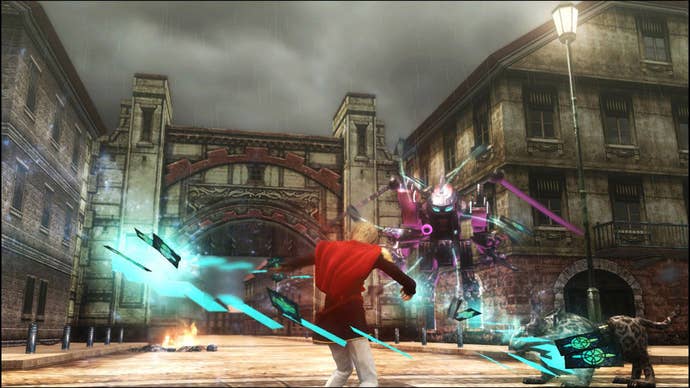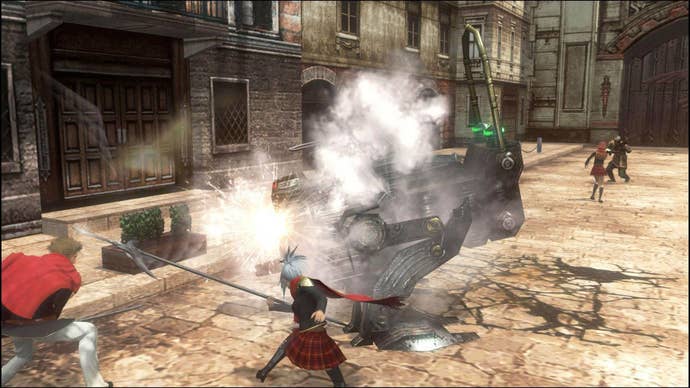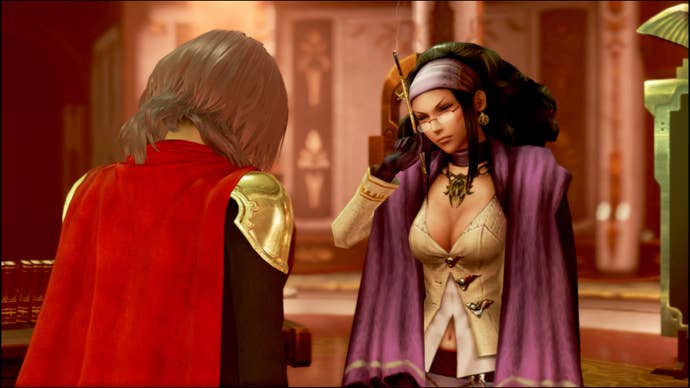Final Fantasy Type 0 HD Review: For Old Times' Sake
Though fixated on death, this spin-off bodes well for Final Fantasy's future liveliness.
This article first appeared on USgamer, a partner publication of VG247. Some content, such as this article, has been migrated to VG247 for posterity after USgamer's closure - but it has not been edited or further vetted by the VG247 team.
25 years ago, the "Summer of Final Fantasy" captured my imagination. I didn't really know what Final Fantasy was at the time, nor did I particularly care that said "summer" was just a marketing invention being peddled by Nintendo Power to drum up interest in role-playing games among American players after their big Dragon Warrior push had fallen flat. The campaign worked: This "Final Fantasy" game looked vast, intimidating, enormous, impressive, essential. I was intrigued.
Before I had the chance to buy the game for myself, though, a friend of mine picked up a copy and showed it off to me. What a bizarre game, I thought to myself. The parts where he roamed around the world reminded me of The Legend of Zelda and Dragon Warrior, but then he'd enter into combat and everything would be different. A small army of monsters would take turn trading blows with his team of heroes in an abstract but coherent fashion. The heroes themselves were these cute little munchkins lining the right side of the screen, while the bad guys were rendered with breathtaking detail — more illustration than video game sprite.
The enigma of it all only served to increase my curiosity, so that when I finally played the game a couple of months later I felt determined to see the adventure to its conclusion — even though, quite frankly, I had only a vague understanding of its systems and mechanics, even at the end. Its style and intricacy engaged my imagination enough to help me power through its confusing complexity. I was hooked.
Nearly 25 years later, Final Fantasy no longer holds any mystery for me. I've played just about every game to bear the name, completing most of them. I've met and interviewed practically every key figure in the series' history, visited the developers' headquarters, and debated the merits of various entries in the franchise ad nauseum in reviews and podcasts alike. The newness is gone forever for me.
The series' millions of other fans have all come into Final Fantasy at different points in its history, and each one responds to different traits of the games. Some lost their interest when story came to the forefront in the 16-bit era, or when cinematic presentation took center stage in the PlayStation days. Many fans who jumped on board with Final Fantasy VI hated Final Fantasy VII, and those who flocked to the series with Final Fantasy VII were horrified by the wildly different approach Final Fantasy VIII took. And so it goes; each new chapter of the series seems almost scientifically calculated to drive away newfound fans. Could the three sequels to Final Fantasy X possibly have been any less alike to that game, and to one another? From linear story to sprawling MMO to bizarre open-world hybrid adventure to ultra-linear story again, numbered entries in Final Fantasy have come to feel less like sequels to what's come before than a repudiation of it all.

So when I see people on social media gushing about how Final Fantasy Type 0 HD and the Final Fantasy XV demo packed inside makes the series "truly feel like Final Fantasy again," I have to wonder what they're responding to. Not that I necessarily disagree with the sentiment; rather, a phrase like "truly feels like Final Fantasy" simply leaves a lot to be unpacked. Neither of these games features turn-based combat, the classic Job system, Materia or Magicite to equip, or any of the numerous other classic markers people remember when they think of old-school Final Fantasy. So just what about Type 0 is so "true" to the series' spirit?
For me, at least, what connects Type 0 to its long-ago predecessors is the fact that it's managed to surprise me, and more than once — something I haven't experienced with this franchise since I took Vaan and company through the gates of Rabinastre and into the vast world of Final Fantasy XII. Maybe the shock isn't as profound as when I first watched those stumpy NES sprites waving at detailed drawings of wolves and goblins until they won the battle, but it's surprise nonetheless. Sometimes the surprise comes in how closely Type 0 borrows seemingly forgotten elements of its own heritage. It has a world map where everything is wildly out of scale, your heroes being nearly the size of a town icon, and unseen enemies attack at random, launching you into standalone combat sequences. That's archaic game design! Everyone hates random battles and abstract game worlds! And yet, it feels right.
Meanwhile, the setting feels like Final Fantasy VIII's Garden military academy done justice at last, with conflicts taking on a scale and severity far more in line with what you'd expect from a full war between nations. You can raise Chocobos on a farm, just like in FFVII. Swapping between three active characters connects the series to the Final Fantasy XIII games; clearly, I now realize, this is where the costume-change mechanic in Lightning Returns came from, even moreso than from Final Fantasy X-2. And summoned beasts feel grander and more important than ever before, thanks in large part to the tremendous tradeoff involved in calling them into battle: To evoke a summon, a party member must sacrifice his life.
And that's where Type 0 surprises me most, I think. It's a massive RPG that draws heavily on Final Fantasy's history, but at the same time it also exists as a rumination on mortality. Death and dying permeate the story at every level; they drive the characters; they define the world; they shape the combat mechanics. It could seem morbid, coming in the service of a series so many gamers are happy to write off as dead and done with. Instead, it feels like a meditation on modern culture and the perils of tuning out — again, much like Final Fantasy VIII, but more expertly done.
In Type 0's world of Orience, people have lost the ability to remember the dead. When someone falls in battle or to illness, those who knew them in life immediately lose their memories of that person — even a sibling or parent. Only written records remain, reminding the living that someone dear to them has been lost, even though they no longer have any memory of that person. The stated idea behind this gap in memory is to ease the lives of the living, to allow them to carry on in the face of loss, but ultimately it serves as a system to facilitate Orience's state of perpetual conflict: Without the fear of death and loss, the people of this realm can more eagerly throw their lives away on the battlefield.
This rule of life plays a profound and affecting part in the stories of the game's main characters — the 14 students of Akademeia's Class 0 — but it also finds an echo in the mechanics of combat. When the team departs Akademeia, the class members can fall in combat. Barring the use of rare and expensive items like phoenix pinions, the dead remain dead until the end of the mission, when they're brought back to life by their caretaker (a mysterious woman who calls herself their "Mother"), one of several abilities that sets the members of Class 0 apart from their peers. It's a rare and welcome integration of story and cutscene mechanics, an answer to everyone who ever asked, "Why couldn't Cloud revive Aerith with a Life spell?" The game begins with a drawn-out sequence in which a student of Akademeia dies a valiant death, wounded far beyond the ability of a Cure spell to heal, and that finality plays into the action. Should a member of Class 0 fall in action — whether at the hand of a foe or by the self-sacrifice required to summon an Eidolon — they remain out of action for the remainder of that mission. When the entire class falls, the game ends.
It's the thoughtful details of Final Fantasy Type 0 that make it stand out. Where most Final Fantasy games give lip service in-story to combat and character-building mechanics, no system in Type 0 is taken for granted. Eidolons come with a steep cost. The "Fablua Nova Crystallis" elements that connect Type 0 to FFXIII feel much more expertly realized here than in that game: The Fal'Cie "gods" are more engimatic, their L'Cie avatars more inhuman (not to mention devastatingly powerful). Systems have more presence in the world, from the Phantoma energy you collect from defeated foes to the simple fact that death is not some minor inconvenience to be brushed aside. And this is a game with a lot of systems... which unfortunately ties back into its biggest obstacle: Its portable nature.

There's no doubt that Type 0 began life as a portable title. Despite the HD appended to the title, it looks and plays exactly like you'd expect a PSP game to play. The HUD has been boosted in resolution, and the standard in-game models for party members and major NPCs have been swapped out with their more detailed cutscene models. But it's a sparse game at times, with a world consisting of big blank boxes and minor characters whose low visual fidelity stands at hilarious odds with the intricate main cast. It's to be expected, but the tech-obsessed will be disappointed that an "HD" Final Fantasy game seems so low in visual polish even as the frame rate runs at half the golden standard of 60fps.
Still, that's all just superficial. More materially harmful to the game experience is that so many portable-focused limitations and requirements remain in place on PlayStation 4 and Xbox One. Much like director Hajime Tabata's previous PSP titles, Crisis Core and The 3rd Birthday, Type 0's action sequences transpire in a series of interconnected, self-contained boxes. They might be disguised as rooms, courtyards, caves, or crystalline chambers, but they still amount to big rectangular boxes with a couple seconds of loading time between them. This structure clearly was put in place to accommodate the RAM limitations of the PSP, and as a tradeoff for the best visuals on the system, but on current consoles the boxed-in design feels stifling and disruptive.

Most of all, Type 0 also betrays a portable sensibility to its balancing and mission design — its systems take after other portable games like Monster Hunter and Pokémon, and demonstrate why those games have never taken off on consoles. Type 0 has you juggling 14 different party members, all of whom have to be leveled-up individually, and who only gain experience while in active combat. But only three characters can be active at a time. Worse, if you choose to focus on building up SPP (another form of in-game "currency") by allowing random fighters from other classes join your party, they'll take the place of your two Class 0 companions, meaning only the lead character gains combat experience.
You need to make use of all the characters to avoid any of them being left behind... and given the scarcity of revival items, it pays not to have the third-stringers underpowered, as you'll have to rely on them in the worst possible situations, when the rest of Class 0 has been wiped out. This was clearly a game designed to kill time on a train commute or in a classroom over the course of several weeks, and these requirements don't translate cleanly to sitting at a console for hours at a time. It's all somewhat mitigated by the addition of a New Game +, which is the only way you can even begin to hope to see all the side quests and alternate-angle content that reveals the full story, but nevertheless you'll have to dally in a significant amount of busywork in order to reach the end.
While the overly faithful nature of this port definitely undermines its impact, the fact that we're even seeing it in the U.S. at all — let alone on a current-gen system! — is no small miracle. And, I suspect, it's a signifier of what Type 0 truly represents: A mission statement for the future of Final Fantasy, likely the work whose strength both as a fond love letter to the series history and an attempt to push the series' nuts-and-bolts in a more future-facing style earmarked Tabata as the idea choice to bring the struggling Final Fantasy XV to life. Final Fantasy sits a long way from the NES game some of us old-timers played 25 years ago, but the best parts of that original spirit live on.
VisualsType 0's visuals are all over the place. The main party members look pretty great, and the FMV sequence stand out... but this is an up-rezzed PSP game, and it looks it.
SoundFinal Fantasy games always have great audio design, and Type 0 is no different. The bombastic themes may not be memorable, but they fit the grand scale of the game.
InterfaceIt could be better... much better. A hyperactive camera, an unpredictable lock-on system, and some deeply confusing menu systems take a lot of getting used to.
Lasting AppealDespite the flawed artifacts of its humble origins, Type 0 tells an engrossing tale with a great cast of characters and some surprisingly effective story themes. You could easily sink 100 hours into it, and for the most part they'd be thoroughly enjoyable ones.
ConclusionIt's been a long time coming, and by and large Final Fantasy Type 0 is worth the wait. Despite some dated visuals and mechanics better suited for a last-generation portable system, and despite being greatly overshadowed by the Final Fantasy XV demo it ships with, Type 0 deserves the attention and respect of Final Fantasy fans. While last year's Bravely Default garnered praise for being a reprise of old-school Final Fantasy, Type 0 proves you can be progressive rather than regressive and still capture the series' spirit (whatever that means for you) quite neatly.


